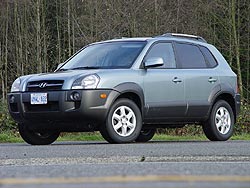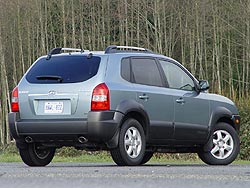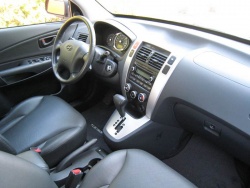 2005 Hyundai Tucson; photo by Greg Wilson. Click image to enlarge |
|
Related articles on Autos
Manufacturer’s web site
|
By Chris Chase
Find this vehicle in Autos’s Classified Ads
Introduced in 2005, the Hyundai Tucson was way late to the compact crossover party, a bash that started in 1997 when the Honda CR-V and Toyota RAV4 first flicked on the lights in what would soon become a very hip piece of the marketplace.
But like so many latecomers have proven, you don’t have to have been first in order to be good at something. While the Tucson won many sales based on Hyundai’s typical budget pricing, it also proved to be a very nicely-built vehicle for its price.
The Tucson could be had with either a 2.0-litre, four-cylinder engine (140 hp) or a 2.7-litre V6 (173 hp). The four-cylinder was available with a five-speed manual or four-speed automatic transmission, while the V6 was paired with the automatic exclusively. Naturally, all-wheel drive was offered too, but only with the six-cylinder engine.
 2005 Hyundai Tucson; photo by Greg Wilson. Click image to enlarge |
In 2006, a four-cylinder, five-speed manual transmission model could be had with all-wheel drive, but not with the automatic. The V6 version continued to be offered in front- and all-wheel drive. That four-cylinder, all-wheel drive model was dropped in 2007, leaving all-wheel solely to the six-cylinder models once again.
2009 models got a mild – almost indistinguishable – styling update in advance of a complete redesign for 2010.
Fuel consumption ratings in 2005 were 10.7/8.0 L/100 km (city/highway) for four-cylinder models with either transmission, while V6 models were rated 11.9/8.4 (FWD) and 12.3/8.8 (AWD). The four-cylinder’s numbers improved slightly through the model run, to finish out at 10.5/7.6 with the manual transmission and 10.2/8.0 with the automatic. The V6’s figures remained more or less the same until 2009, when its city-cycle consumption improved notably, to 11.3/8.4 (FWD) and 11.6/8.8 (AWD).
The Tucson could be a poster child for Hyundai’s constantly improving quality, earning an above-average used vehicle rating from Consumer Reports, and a spot on the publication’s used vehicle “good bet” list.
  2005 Hyundai Tucson GL four-cylinder, by Haney Louka (top); 2008 Hyundai Tucson Limited FWD, by Jil McIntosh (bottom). Click image to enlarge |
Many owners report frequent dead batteries in Tucsons, a problem attributed to a radio that siphons electricity even when the car is off. Consumer Reports notes this in its reliability data on the Tucson; the publication also notes radio troubles, which I suspect are related to the same problem.
An illuminated check engine light could indicate a misfire in the engine’s ignition system, ultimately caused by a bad fuel pump or clogged fuel filter.
Also, early Tucsons had a problem with their anti-lock braking system, which would randomly activate the brakes at one wheel. This issue was covered by a recall issued in 2005.
Anecdotal information found in Internet discussion forums tends to be a good barometer of a vehicle’s overall durability, and in the Tucson’s case, it corroborates CR’s data and the magazine’s high opinion of the car.







 Follow Autos on Twitter
Follow Autos on Twitter



